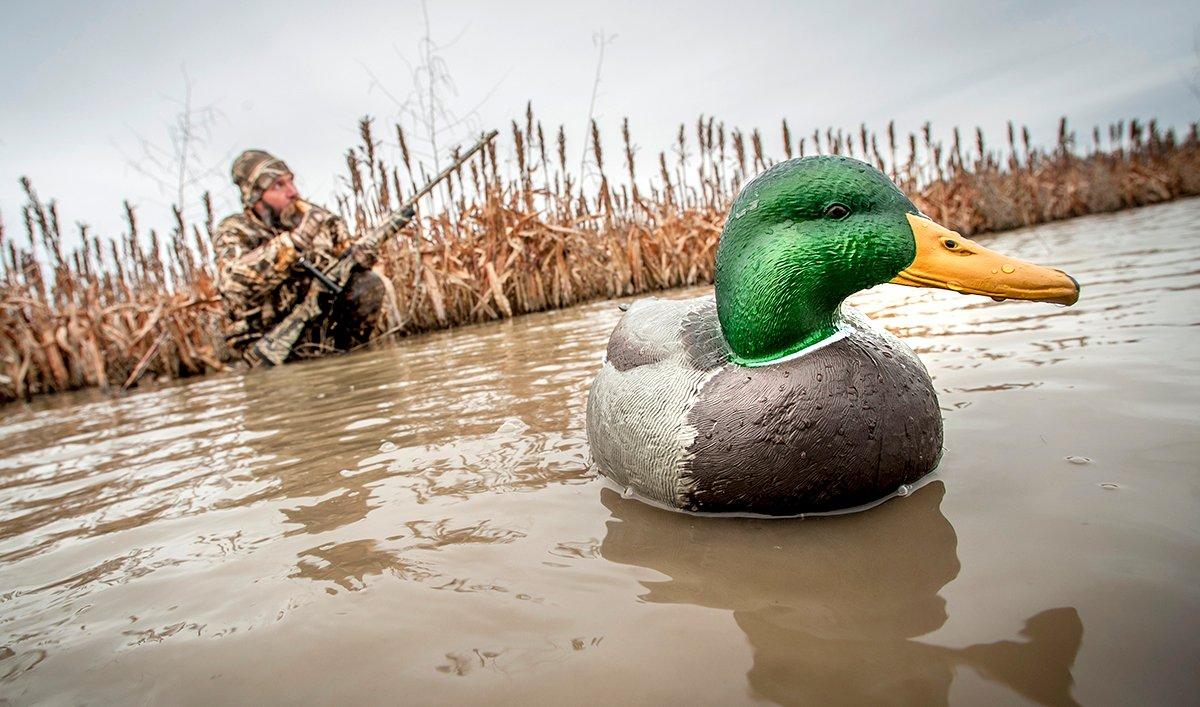Motion brings in ducks. Here's how to add movement to your decoys
We were running late. Someone who shall remain nameless (OK, it was me) forgot to pull the drain plug the night before, and a late-evening rain had filled the boat with about 2 inches of water that subsequently froze overnight.
Pulling into the slough, we clearly saw a spotlight working the cattails around the X, so we motored across several hundred yards and set up on Plan B. As daylight broke, I made out a spinner decoy working and a few dozen blocks set up where I'd planned to be. Upset that my folly had cost us the A spot, I pulled out the binos to scope their setup. They had the right spread, it looked good and they were sitting exactly where we'd been seeing birds work. In a few minutes, the first group of ducks flew straight to their spread, circled twice and then flew off.
The next group did the same, except they bent toward my group and committed with no hesitation. Four greenheads fell with the first volley, and while the dog was picking up the last bird, I put the binos on our competitors' spot to see what was making birds flare. It was obvious in the clear light. Their spread was dead. A 2-knot breeze barely caused a ripple on the water, and although they were using the spinning-wing decoy, the water surrounding their decoy spread was calm. In contrast, our jerk strings coupled with two butt-up feeders fitted with bilge pumps were making quite the commotion.
During the morning, Plan B turned into a three-man limit, and the X was an avian desert. Even though the ducks wanted to be in that little corner, the lifeless spread pushed them out and into our laps because our spread had life.
Jerk Strings
Jerk strings are inexpensive, easily deployed and add realism to any decoy spread. Several companies make and sell decoy jerk rigs, some fancier and more complex than others, but they will all work. In fact, when dealing with cold water, metal clips and lengths of small-diameter rope, I prefer the keep-it-simple-stupid mentality. One jerk string with a half-dozen decoys attached is plenty when running 12 to 16 decoys. For larger spreads, you need multiple strings to ensure the entire spread is covered. You can run multiple single rigs, but the Rig 'em Right Mega Motion combines three jerk cords and attaches them to one main line, making it easy to move up to 18 decoys with one hunter. As the name says, it adds mega motion to the spread.
Some folks make their own jerk cords, and it's quite easy. All you need is about 80 feet of 1/8-inch braided rope, a half-dozen heavy fishing swivels with clips, a section on bungee cord and a stake or anchor to tie off the ensemble. Attach the anchor or stake to the bungee and the line to the other end of the bungee, and then space the swivels out about every 3 or 4 feet. You'll also need one of those electric cord winders from a hardware store to keep the line from getting tangled. Although there's some satisfaction from doing it yourself, the cost of building your own jerk rig adds up to about the same or a little more than buying one already made. The choice, my friend, is yours.
Squirters
We call them squirters, but the long description is a butt-up bilge feeder decoy. A few companies offer these, but I prefer the Higdon Pulsator. It's reliable, runs off a self-contained, rechargeable battery, and provides the right amount of splash and motion. My friends and I typically put one or two in the middle of the spread away from the landing zone to simulate feeding ducks at a distance. Although they don't provide a lot of ripple effect, the squirting water from the bilge looks like a group of ducks feeding in the distance, and I've come to rely on them heavily, especially in conjunction with jerk strings when hunting backwater sloughs, which are often sheltered from the wind. Just like jerk strings, you can make your own, but without getting into too much detail, they involve a lot of moving parts, electronics and things that can go wrong in the construction, so in this case, I suggest buying a unit from your local sporting-goods store and calling it good.
Swimmers, Splashers and the Rest
A lot of time, money and ingenuity have been poured into various forms of waterfowl trickery. From remote-control swimming ducks to automatic jerk strings, the market has become flooded with all sorts of motion gimmicks. In the end, buy what suits your fancy, but I tend to flare off when excessive set-up time, battery cables and remote controls come into the fray. Call me old-fashioned, but I believe what can go wrong will, with the words of my father, Electricity and water don't mix, ringing in my ears.
One exception is the Wonderduck decoy which uses paddles on either side of full-sized and butt feeder decoys. I don't own one, but a few hunting buddies do, and they swear by them. The units are powered by AA batteries, which, in my experience, never last as long as you want them to. Nonetheless, I've watched these contraptions in action, and they work. Apparently, ducks are not that spooked by a decoy spinning around in tight circles.
Click here for more Realtree waterfowl hunting content. And check us out on Facebook.







